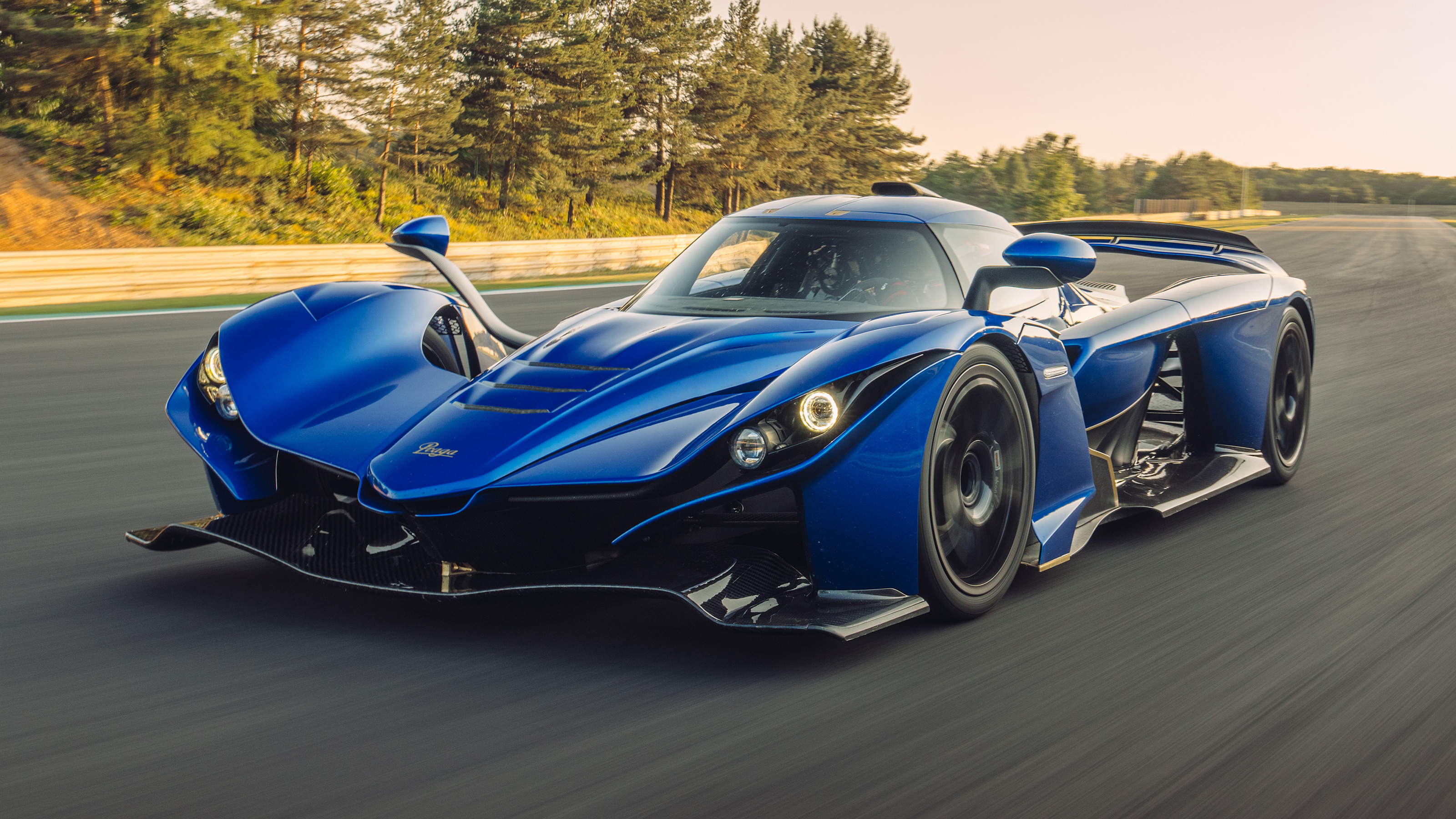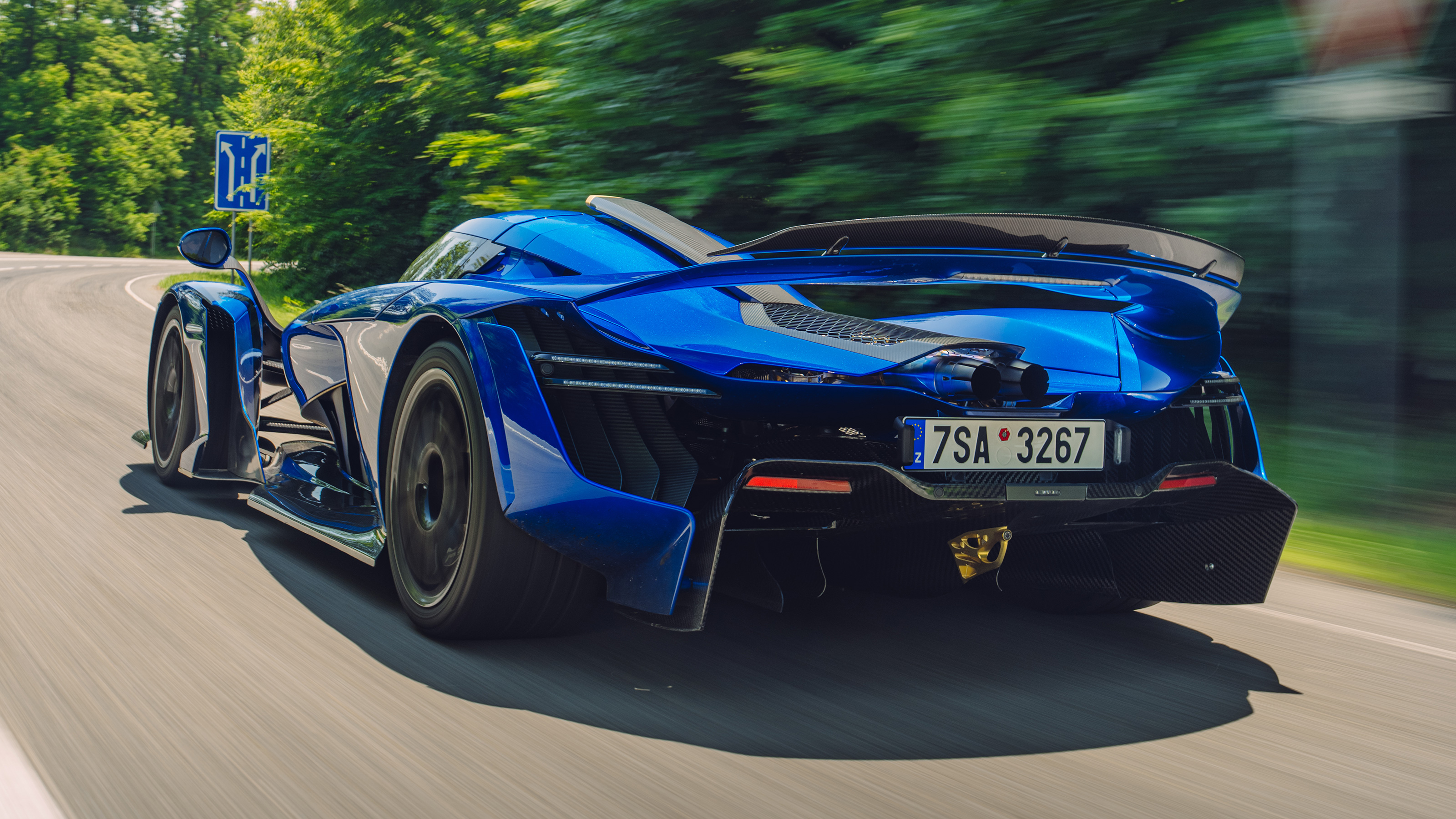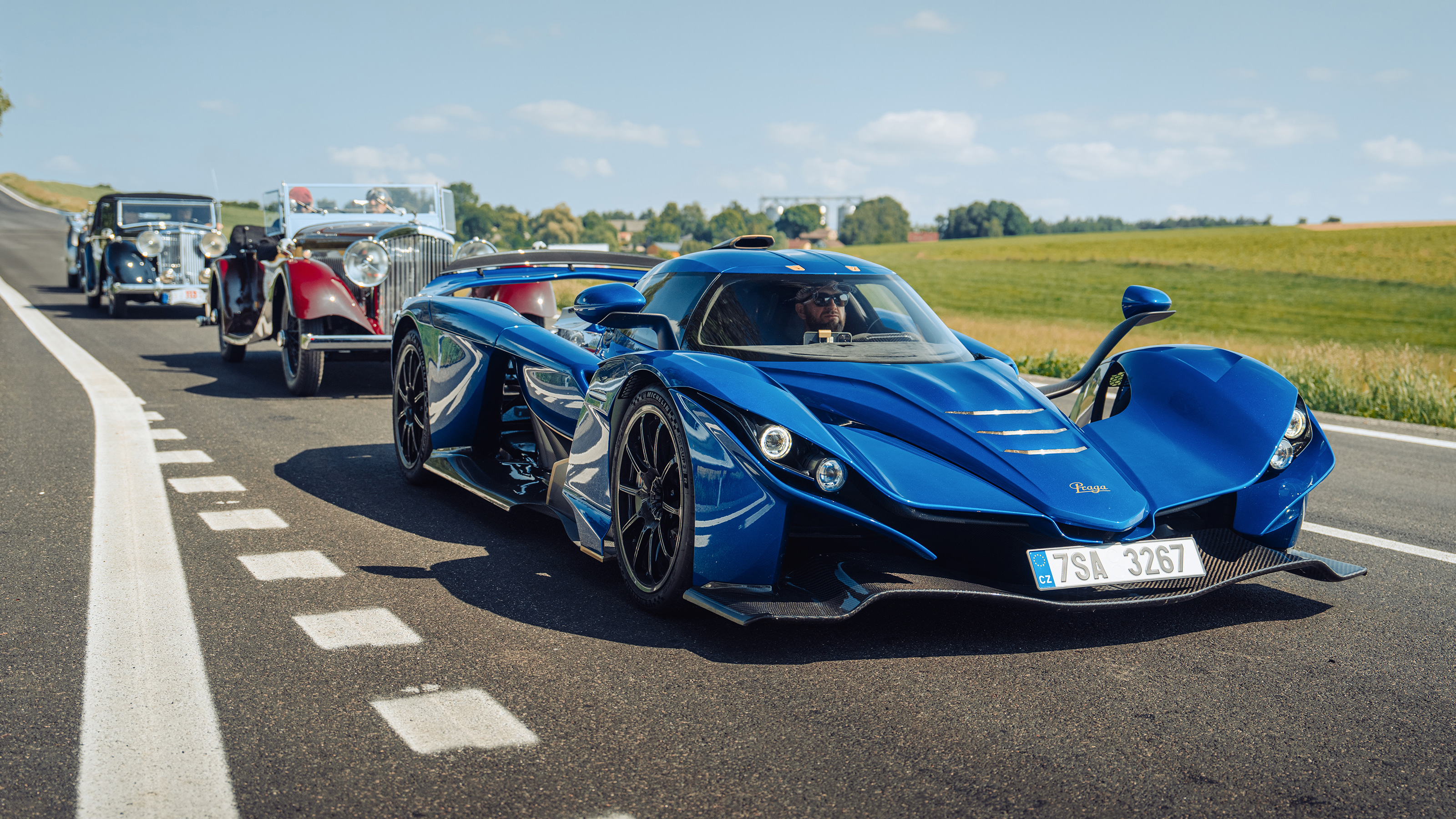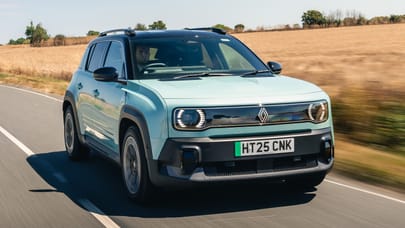
Praga Bohema review: the 700bhp twin-turbo V6 insect propellant
£1,440,000 when new
What is it?
It’s a very expensive, track-focussed hypercar from the Czech Republic. A track munition from a little-known manufacturer, powered by a Japanese engine tuned by a UK company. It’s rear-wheel drive, operates from six sequential speeds of single-clutch paddle – never the last word in refinement – and has no cupholders.
It also has no hybrid assistance, a distinct lack of electric boost, isn’t drowning in computing and has ‘only’ 700bhp. Oh, and it weighs under a tonne.
It is the Praga Bohema, and it’s not for the weak. But we love it.
Explain, please?
Carbon tub, carbon body, carbon seats, lots of words with ‘carbon’ written in front of them. Biturbo V6 slung in the middle rather than positioned as a stressed member (this is supposed to be usable on the road), to prevent the engine’s unfriendly resonant frequencies from using the carbon passenger cell as a subwoofer and turning the occupants’ ears inside out.
The engine is a 3.8-litre, and comes with some provenance – yep, it’s the VR38DETT from the Nissan R-35 GT-R. An engine that's been on sale since 2009, and died with the GT-R in 2022. So not massively exotic. Except that Nissan has never really allowed this design to be used in anything other than racing cars and a couple of concepts.
So it's still special. It's tuned by UK power brokers Litchfield to produce an entirely reliable 700bhp. Which these days sounds a bit white wine spritzer rather than shot of whisky. Similarly, 0-62mph in 3.3 seconds and 186mph+ won’t necessarily satisfy the stat-collectors and paper players.
So why are we interested?
As mentioned, the Bohema weighs under a tonne and is essentially a giant, insectile aero device. That's the same power as something like a McLaren 720S, but 300kg lighter. Or a couple of hundred kilos lighter than an Aston Martin Valkyrie wet. It produces the greater proportion of its kerbweight in downforce at 155mph, some 950kg for 982kg of mass. It’s about what happens in a corner, not altogether in the straight bits. Ever heard the phrase ‘slow in, fast out’ for muscle cars that are powerful but weigh a lot? This is ‘fast in, faster out, brace your core’.
It tends not to really just drive around a corner. It hunts them. Like prey.
That sounds interesting. But who the hell is Praga?
The Czech Republic’s answer to VW back in the day. Or possibly Aston Martin. A revival and refresh in the past decade or so of a very old company. Probably not the first name that pops up when you think of hypercar hall-of-famers, but it’s making an impression.
Born in the Czech Republic in 1907, Praga started out making cars, trains and buses, and has a long and storied history. These days it makes a variety of stuff; the single-seat Praga R1 track car – a tiny track-only Batmobile from which the Bohema very obviously learns the greater proportion of its lessons – the gorgeous Praga ZS800 motorcycle, the V4S DKR Dakar racing trucks, even a Praga aeroplane.
Top Gear
Newsletter
Thank you for subscribing to our newsletter. Look out for your regular round-up of news, reviews and offers in your inbox.
Get all the latest news, reviews and exclusives, direct to your inbox.
And the name? Praga is the name of the home city – Prague – which was the traditional capital of the region of Bohemia back in the day. Hence Praga Bohema.
So have they managed to make the Bohema convincing?
Remarkably, yes. The trick with this car is that it is remarkably self-aware. It knows it won’t appeal to everyone, but those it will appeal to will be drawn to it in no uncertain terms. It’s a track car that can be driven on the road, but more importantly, it’s a blistering track car that can be driven on the road.
We visited three racetracks in the course of testing (Autodrom Most, Brno Circuit and Slovakia Ring) with previous roadcar lap records all held by the somewhat inevitable Porsche 911 GT3 RS. The Bohema mullered the records by a minimum of four seconds in the hands of Praga’s test driver Ales Jirasek (below), and that’s without specific set-ups – just a lowering of the ride height and removing of the licence plates. Which are themselves quick release with magnetic phone charger backings that keep the ‘plate lights on.
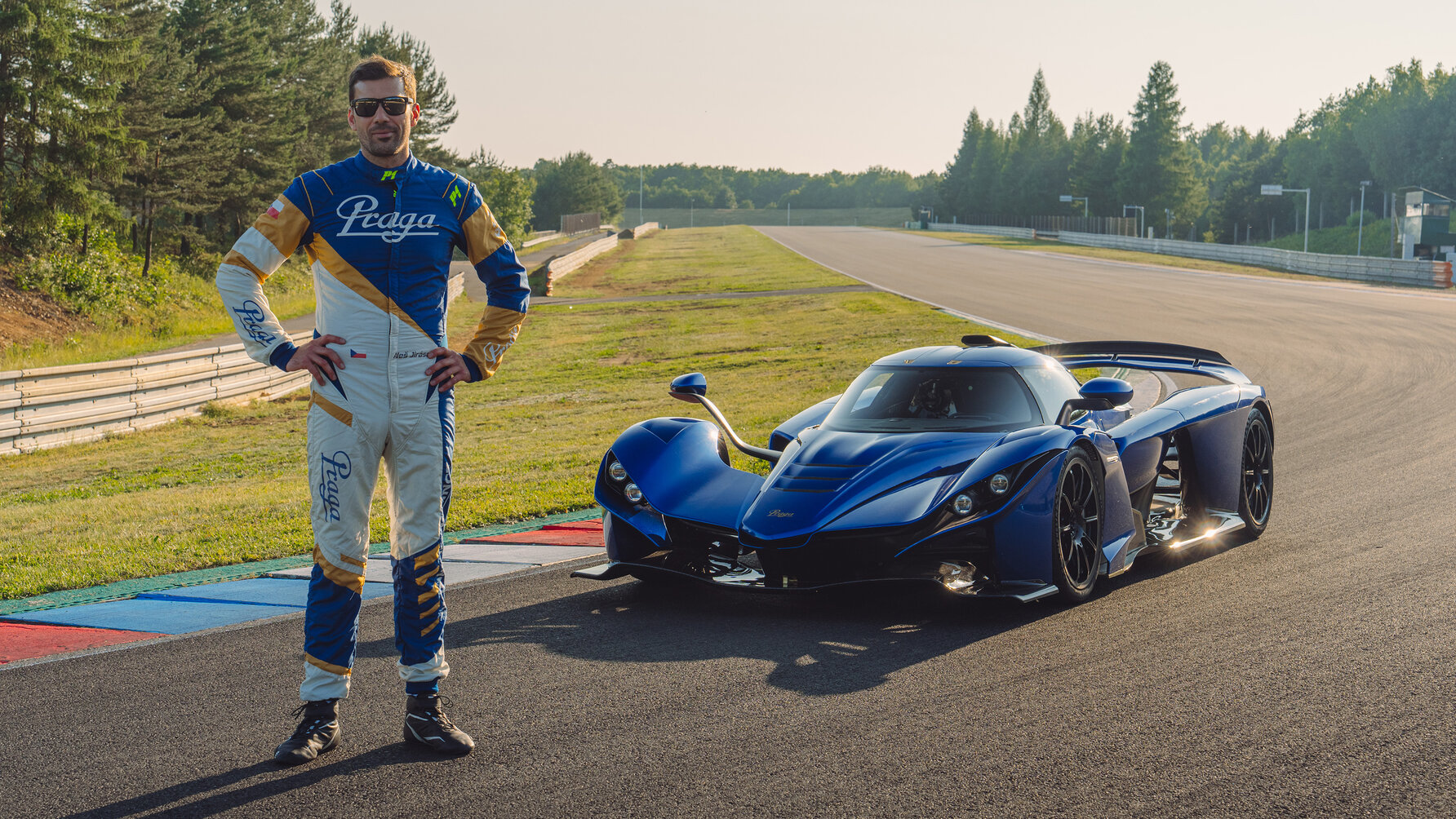
You can lower the car via the inboard pushrods with two spanners and a caliper or tape measure – it’s not too much hassle, probably 30 minutes. And yes, even in the hands of a non-pro, it’s incredibly fast, light to the touch and satisfyingly raw.
A blood, bone and brass experience rather than something that relies on code and traction control, it’s a bit old-school. In fact, it’s the kind of thing that encourages you to up your driving game – the speed is there to access, the last seconds not given up quite so easily.
So let’s drill into this: is it actually any good on a track?
Shades of Le Mans Prototype, so seriously quick, with little prep. The acceleration is actually within the realms of super/hypercar knowledge, but the impressive bit is actually more in the braking and turn-in phase. You stand on the brake pedal with as much force as you can muster, then drive the yoke wheel at the apex. You don’t manage the weight so much as just tell it where you want to go and hold on. It’s a downforce car, so it’s not really interested in sliding or showy nonsense, but no less captivating for that.
And that grumpy Hewland sequential ‘box that hangs up if you’re indecisive on the road becomes a hyper-focussed bin-kicker when you give it death on a track. Blistering upshifts and brutal downshifts on the brakes. It has one job to do, and it does it well – even if engaging first gear on the road always sounds (and feels) like someone just slammed a door right behind your head. And yes, it has the shiver and shake of a racecar sequential at idle, and the kangaroo-judder of a racing car pull away.
Not interested in track driving? The Bohema might convince you – anyone interested in the control and management of a very fast car, the actual driving bit, will find it fascinating. While hypercars are actually very easy to drive once you’ve got used to the width/speed/attention, the Bohema actually needs you to put some time in to drive it to the limit, be that on road or track. There’s something innately satisfying in that.
So that means it probably eats your brain on a road?
It’s… committed. The Hewland can be tricky, and you have to blend the clutch actuation from the throttle pedal – or the behind-wheel clutch paddle in racier modes. It’s noisy and doesn’t have tonnes of ride height. Plus, jumping in and out isn’t an elegant process. But you do get used to it.
Entry and egress gets more convincing with familiarity, popping the key into its recess in the tub before entry leaves both hands free, and even though it makes a lot of noise, it’s not deafening; you don’t need ear defenders to have a normal conversation.
And then there’s the little thoughtful bits that make it a touch more usable. The air con blows cold. You can seat two, even if it is a bit snug. The ride is hard, but the expensive Öhlins dampers still suspend with distinct mercy even given the limited amount of spring and damper travel.
Once in, you plop your phone into the holder atop the central column – very Dacia Duster – and plug it into the USB hidden behind: it becomes an always-updated ‘nav that stays updated and weighs grammes. There’s a pocket by your left thigh for a wallet, easily changed mirrors, a bottle/flask holder behind your head in the central spine that can also be used to house a Bose bluetooth speaker. And yes, you’d be able to hear it.
There’s a button panel and rotary wheel combo in the headliner that’s absolute genius; click a button to engage the mode, spin the wheel to adjust. You can do it by feel, and it makes so much sense in a car where you don’t get much time ‘off’ at the wheel – there’s no sneeze factor, so being able to adjust the air-con by touch without a complex screen is fabulous.
It’s also got a decently-sized fuel tank (over 60-litres), and remarkably, driven normally, registered 35-ish mpg. That’s not a plug-in hybrid-assisted bit of special maths, either.
Are we talking perfect compromise?
No. It’s absolutely compromised for road work, but those compromises are celebrated. The Bohema might well be too much for some, with too tight a focus; might be considered not V12 enough for those who need more exotic powertrains. That Hewland six-speed sequential can be annoying, loud and unrefined – it’s not the car to wear tight trousers or a short skirt in. But all of that is part of the Bohema’s character. You get it… or you don’t. There is no in-between.
What makes it better than… the other mega-expensive track things?
There are a few things that make the Bohema attractive. It’s got a low-access starting point in terms of skill, but a high limit when it comes to absolutes; both normal people and racing drivers will find a place here.
It also doesn’t need a 45-second start-up procedure, a team of engineers or particular fettling. The GT-R engine is there to be abused, and it’s so reliable Praga actually offers an unlimited mileage warranty for road work.
Plus, there’s the vague option of tuning: the Bohema doesn’t particularly need more power, but Litchfield does VR38DETTs like no one else, and offers billet 4.3 blocks with upwards of 1,200bhp – the idea of a Bohema with a 1:1 power-to-weight ratio is absolutely possible. And lightly terrifying.
Why do you like it? You hate everything track-biased!
Jan Martinek (below, right) – technical director at Praga and overlord of the Bohema project – is one of us. As are the people that have developed it. It takes lessons learned from the R1 pure track car, and sympathetically translates them into a real road car.

But more than that, Martinek is obsessed. In a good way. While he appreciates and admires innovation – be that hybrid, electric, coal, steam or fairy dust – he’s of the opinion that a hypercar’s job is to make you smile, be you teenage onlooker or serious driver.
The Bohema is singular, odd, complex and fascinating. Not your usual hypercar. And that makes it very special indeed.
Featured

Trending this week
- Car Review
BMW iX3




